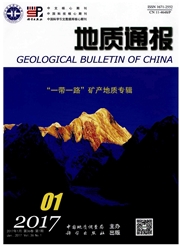

 中文摘要:
中文摘要:
早一中元古代,上扬子陆块西南缘发育有河口群一大红山群、东川群、昆阳群一会理群为代表的3套浅变质火山一沉积岩系。已有的岩石学、地球化学、年代同位素数据指示了其大地构造格架及其演化史。在早一中元古代地层所夹的火山岩中,获得了4组SHRIMPU—Pb岩浆锆石年龄:1800~1600Ma、1600~1300Ma、1300~1100Ma、ll00~1000Ma。结合沉积相、常量、微量、稀土元素地球化学分析,证明了上扬子陆块西南缘在早一中元古代也相应历经了4个演化阶段。1800~1600Ma,在大红山地区、河口地区、东川汤丹地区形成近东西向的裂谷盆地。1600~1300Ma,在东川因民地区表现为一被动陆缘下的伸张环境。1300~1100Ma,在菜籽园一麻塘地区为板内裂谷一洋盆,老武山地区为裂谷盆地。1100~1000Ma阶段,菜籽园一麻塘裂谷一洋盆向北俯冲或向北向南双向俯冲,在北边的天宝山地区和南边的富良棚地区形成火山岛弧,同时在扬子西缘也出现了1.0Ga左右(1007±14~1014±8Ma)的同造山或同碰撞型花岗岩,表明此时康滇地区已经拼贴到一起,并与整个上扬子陆块Rodinia超大陆形成同步。
 英文摘要:
英文摘要:
During Paleo- and Mesoroterozoic epochs, three sets of low metamorphism sedimentary and volcanic successions represented by the Hekou Gr. , Dahongshan Gr. , Dongehuan Gr. , Kunyang Gr. And Huili Gr. were developed within the southwestern margin of upper Yangtze block. Previous studies of petrology, geochemistry and geochronology show its tectonic framework and evolution history. Four SHRIMP U-Pb ages of magmatic zircons from the volcanic rocks hosted in the Paleo- and Mesoproterozoic strata were yielded. 1800 ~ 1600Ma, 1600 ~ 1300Ma, 1300 ~ 1100Ma and 1100 ~ 1000Ma. Along with sedimentary facies, major, trace and rare earth elements chemical data indicate that the southwestern margin of the upper Yangtze block experienced four development stages during Paleo- and Mesoproterozoic. At ca. 1800 ~ 1600 Ma, a near EW-trending rift basin was developed within the Dahongshan, Hekou, and Dongchuan areas. At ca. 1600~1300Ma, the Dongchuan area was in a passive continental extensional setting. At ca. 1300~ ll00Ma, the Caiziyuan-Matang areas were the intrapiate rift-oceanic basin while the Laowushan area was a rifting basin. At ca. 1100~1100Ma, the Caiziyuan- Matang rift- ceanic basin subducted northward or both northward and southward to form volcanic arc in Tianbaoshan and Fulingpen areas. Meanwhile, orogensis- or collision-type granite was formed in the western margin of the Yangtze at ca. 1.0Ga (1007 14~1014 8 Ma). All this evidence indicates that Sichuan and Yunnan had jointed together, which, along with the whole upper Yangtze block, formed the Rodinia supereontinent.
 同期刊论文项目
同期刊论文项目
 同项目期刊论文
同项目期刊论文
 期刊信息
期刊信息
